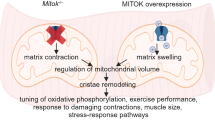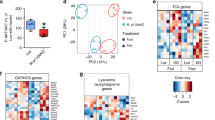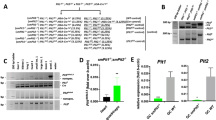Abstract
The intracellular Ca2+ concentration ([Ca2+]i) in skeletal muscles must be rapidly regulated during the excitation-contraction-relaxation process1. However, the signalling components involved in such rapid Ca2+ movement are not fully understood. Here we report that mice deficient in the newly identified PtdInsP (phosphatidylinositol phosphate) phosphatase MIP/MTMR14 (muscle-specific inositol phosphatase) show muscle weakness and fatigue. Muscles isolated from MIP/MTMR14−/− mice produced less contractile force, had markedly prolonged relaxation and showed exacerbated fatigue relative to normal muscles. Further analyses revealed that MIP/MTMR14 deficiency resulted in spontaneous Ca2+ leakage from the internal store — the sarcoplasmic reticulum. This was attributed to decreased metabolism (dephosphorylation) and the subsequent accumulation of MIP/MTMR14 substrates, especially PtdIns(3,5)P2 and PtdIns (3,4)P2. Furthermore, we found that PtdIns(3,5)P2 and PtdIns(3,4)P2 bound to, and directly activated, the Ca2+ release channel (ryanodine receptor 1, RyR1) of the sarcoplasmic reticulum. These studies provide the first evidence that finely controlled PtdInsP levels in muscle cells are essential for maintaining Ca2+ homeostasis and muscle performance.
This is a preview of subscription content, access via your institution
Access options
Subscribe to this journal
Receive 12 print issues and online access
$209.00 per year
only $17.42 per issue
Buy this article
- Purchase on Springer Link
- Instant access to full article PDF
Prices may be subject to local taxes which are calculated during checkout





Similar content being viewed by others
References
MacLennan, D. H. Ca2+ signalling and muscle disease. Eur. J. Biochem. 267, 5291–5297 (2000).
Wishart, M. J. & Dixon, J. E. PTEN and myotubularin phosphatases: from 3-phosphoinositide dephosphorylation to disease. Trends Cell Biol. 12, 579–585 (2002).
Alonso, A. et al. Protein tyrosine phosphatases in the human genome. Cell 117, 699–711 (2004).
Tosch, V. et al. A novel PtdIns3P and PtdIns(3, 5)P2 phosphatase with an inactivating variant in centronuclear myopathy. Hum. Mol. Genet. 15, 3098–3106 (2006).
Zhao, X. et al. Enhanced resistance to fatigue and altered calcium handling properties of sarcalumenin knockout mice. Physiol. Genomics 23, 72–78 (2005).
Nagaraj, R. Y. et al. Increased susceptibility to fatigue of slow- and fast-twitch muscles from mice lacking the MG29 gene. Physiol. Genomics 4, 43–49 (2000).
Nosek, T. M. et al. Functional properties of skeletal muscle from transgenic animals with upregulated heat shock protein 70. Physiol. Genomics 4, 25–33 (2000).
Takeshima, H. et al. Excitation-contraction uncoupling and muscular degeneration in mice lacking functional skeletal muscle ryanodine-receptor gene. Nature 369, 556–559 (1994).
Lai, F. A., Erickson, H. P., Rousseau, E., Liu, Q. Y. & Meissner, G. Purification and reconstitution of the calcium release channel from skeletal muscle. Nature 331, 315–319 (1988).
Pan, Z. et al. Dysfunction of store-operated calcium channel in muscle cells lacking mg29. Nature Cell Biol. 4, 379–383 (2002).
Thastrup, O., Cullen, P. J., Drobak, B. K., Hanley, M. R. & Dawson, A. P. Thapsigargin, a tumor promoter, discharges intracellular Ca2+ stores by specific inhibition of the endoplasmic reticulum Ca2(+)-ATPase. Proc. Natl Acad. Sci. USA 87, 2466–2470 (1990).
Lewis, R. S. The molecular choreography of a store-operated calcium channel. Nature 446, 284–287 (2007).
Merritt, J. E. et al. SKF 96365, a novel inhibitor of receptor-mediated calcium entry. Biochem. J. 271, 515–522 (1990).
Bhogal, M. S. & Colyer, J. Depletion of sarcoplasmic reticulum calcium prompts phosphorylation of phospholamban to stimulate store refilling. Ann. NY Acad. Sci. 853, 260–263 (1998).
Toth, A. et al. Quantitative assessment of [Ca2+]i levels in rat skeletal muscle in vivo. Am. J. Physiol. 275, H1652–1662 (1998).
Michell, R. H., Heath, V. L., Lemmon, M. A. & Dove, S. K. Phosphatidylinositol 3, 5-bisphosphate: metabolism and cellular functions. Trends Biochem. Sci. 31, 52–63 (2006).
Di Paolo, G. & De Camilli, P. Phosphoinositides in cell regulation and membrane dynamics. Nature 443, 651–657 (2006).
Min., J. et al. Forward chemical genetic approach identifies new role for GAPDH in insulin signaling. Nature Chem. Biol. 3, 55–59 (2007).
Niswender, K. D. et al. Immunocytochemical detection of phosphatidylinositol 3-kinase activation by insulin and leptin. J. Histochem. Cytochem. 51, 275–283 (2003).
Ishii, T., Lemas, M. V. & Takeyasu, K. Na(+)-, ouabain-, Ca(2+)-, and thapsigargin-sensitive ATPase activity expressed in chimeras between the calcium and the sodium pump alpha subunits. Proc. Natl Acad. Sci. USA 91, 6103–6107 (1994).
Bartolommei, G. et al. Clotrimazole inhibits the Ca2+-ATPase (SERCA) by interfering with Ca2+ binding and favoring the E2 conformation. J. Biol. Chem. 281, 9547–9551 (2006).
Amran, M. S., Homma, N. & Hashimoto, K. Pharmacology of KB-R7943: a Na+-Ca2+ exchange inhibitor. Cardiovasc. Drug Rev. 21, 255–276 (2003).
Treves, S., Jungbluth, H., Muntoni, F. & Zorzato, F. Congenital muscle disorders with cores: the ryanodine receptor calcium channel paradigm. Curr. Opin. Pharmacol. 8, 319–326 (2008).
Benkusky, N. A., Farrell, E. F. & Valdivia, H. H. Ryanodine receptor channelopathies. Biochem. Biophys. Res. Commun. 322, 1280–1285 (2004).
Zhu, X., Zamudio, F. Z., Olbinski, B. A., Possani, L. D. & Valdivia, H. H. Activation of skeletal ryanodine receptors by two novel scorpion toxins from Buthotus judaicus. J. Biol. Chem. 279, 26588–26596 (2004).
Zhu, X., Ghanta, J., Walker, J. W., Allen, P. D. & Valdivia, H. H. The calmodulin binding region of the skeletal ryanodine receptor acts as a self-modulatory domain. Cell Calcium 35, 165–177 (2004).
Hilgemann, D. W., Feng, S. & Nasuhoglu, C. The complex and intriguing lives of PIP2 with ion channels and transporters. Sci. STKE 2001, RE19 (2001).
Brotto, M. A., Nosek, T. M. & Kolbeck, R. C. Influence of ageing on the fatigability of isolated mouse skeletal muscles from mature and aged mice. Exp. Physiol. 87, 77–82 (2002).
Frock, R. L. et al. Lamin A/C and emerin are critical for skeletal muscle satellite cell differentiation. Genes Dev. 20, 486–500 (2006).
Shin, D. W. et al. A retrograde signal from calsequestrin for the regulation of store-operated Ca2+ entry in skeletal muscle. J. Biol. Chem. 278, 3286–3292 (2003).
Cheung, A. et al. A small-molecule inhibitor of skeletal muscle myosin II. Nature Cell Biol. 4, 83–88 (2002).
Jacquemond, V. Indo-1 fluorescence signals elicited by membrane depolarization in enzymatically isolated mouse skeletal muscle fibers. Biophys. J. 73, 920–928 (1997).
Acknowledgements
We are grateful to D. Chess, M. Chandler, T. Stefan, J. Jacobberger, L. Brotto, N. Wiesleder and J. Ma for technical assistance and helpful discussions. Motor function tests were performed by the Case Western Reserve University Rodent Behavior Core. This work was supported by NIH grants (HL068212 and HL082670) to C.K.Q. and (HL55438) H.H.V., an American Heart Association grant (0535555N) to M.B. and a pilot grant from the Case Center for Transdisciplinary Research on Energetics and Cancer to T.M.N., C.K.Q. and M.B.
Author information
Authors and Affiliations
Contributions
J.S., W.M.Y., M.B., J.A.S. and C.S. conducted the research and summarized the data, and C.K.Q., M.B., H.H.V., T.M.N. and C.G. designed the experiments and wrote the manuscript.
Corresponding author
Ethics declarations
Competing interests
The authors declare no competing financial interests.
Supplementary information
Supplementary Information
Supplementary Information (PDF 451 kb)
Rights and permissions
About this article
Cite this article
Shen, J., Yu, WM., Brotto, M. et al. Deficiency of MIP/MTMR14 phosphatase induces a muscle disorder by disrupting Ca2+ homeostasis. Nat Cell Biol 11, 769–776 (2009). https://doi.org/10.1038/ncb1884
Received:
Accepted:
Published:
Issue Date:
DOI: https://doi.org/10.1038/ncb1884
This article is cited by
-
Myotubularin-related protein 14 suppresses cardiac hypertrophy by inhibiting Akt
Cell Death & Disease (2020)
-
Mice lacking myotubularin-related protein 14 show accelerated high-fat diet-induced lipid accumulation and inflammation
Journal of Physiology and Biochemistry (2017)
-
Deficiency of myotubularin-related protein 14 influences body weight, metabolism, and inflammation in an age-dependent manner
Cell & Bioscience (2015)
-
Phosphoinositides in Ca2+ signaling and excitation–contraction coupling in skeletal muscle: an old player and newcomers
Journal of Muscle Research and Cell Motility (2015)
-
Phosphoinositide substrates of myotubularin affect voltage-activated Ca2+ release in skeletal muscle
Pflügers Archiv - European Journal of Physiology (2014)



